University Essay: Gout, Corticosteroids, and Treatment - NSC2500
VerifiedAdded on 2022/09/24
|10
|2273
|24
Essay
AI Summary
This essay provides a comprehensive overview of gout, a common form of arthritis characterized by hyperuricemia and painful joint inflammation. It delves into the pathophysiology of gout, explaining how the accumulation of monosodium urate (MSU) crystals in joints triggers inflammation through the activation of various inflammatory pathways involving neutrophils, monocytes, and inflammatory cytokines. The essay then focuses on the clinical management of gout, particularly the use of corticosteroids, specifically methylprednisolone (Medrol), to reduce inflammation. It explains the mechanism of action of corticosteroids, highlighting their ability to inhibit pro-inflammatory signals and promote the production of anti-inflammatory cytokines. The pharmacology of methylprednisolone is discussed, including its administration, chemical structure, pharmacodynamics, and potential side effects. The essay concludes by summarizing the key aspects of gout, its pathophysiology, and the role of corticosteroids in managing the condition by inhibiting the production of inflammatory cytokines and promoting the activation of anti-inflammatory cytokines.

Running head: SUBJECT- NSC2500 AND STUDENT ID- U1112475
Gout and Use of Corticosteroids
Name of the Student
Name of the University
Author Note
Gout and Use of Corticosteroids
Name of the Student
Name of the University
Author Note
Paraphrase This Document
Need a fresh take? Get an instant paraphrase of this document with our AI Paraphraser
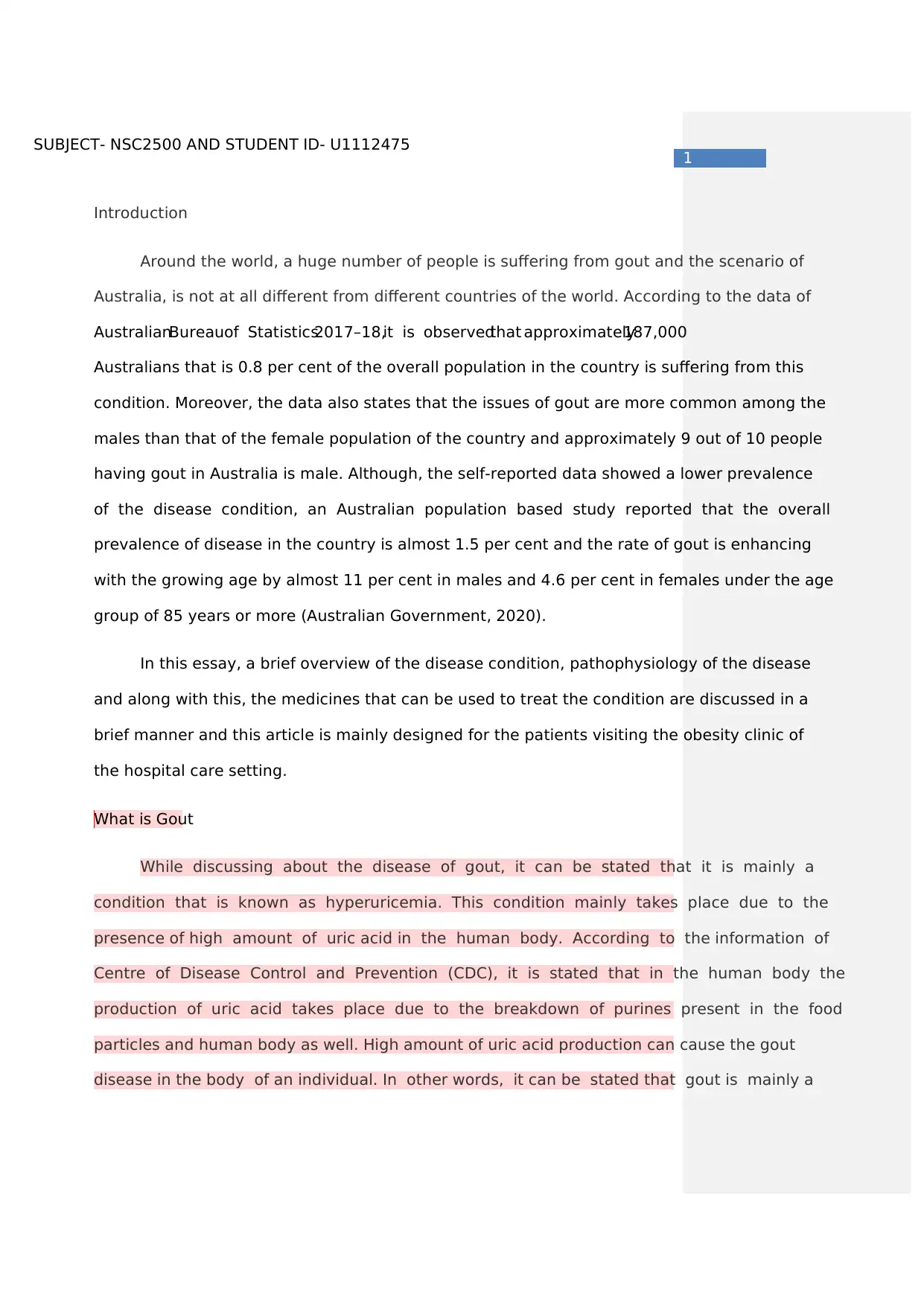
1
SUBJECT- NSC2500 AND STUDENT ID- U1112475
Introduction
Around the world, a huge number of people is suffering from gout and the scenario of
Australia, is not at all different from different countries of the world. According to the data of
AustralianBureauof Statistics2017–18,it is observedthat approximately187,000
Australians that is 0.8 per cent of the overall population in the country is suffering from this
condition. Moreover, the data also states that the issues of gout are more common among the
males than that of the female population of the country and approximately 9 out of 10 people
having gout in Australia is male. Although, the self-reported data showed a lower prevalence
of the disease condition, an Australian population based study reported that the overall
prevalence of disease in the country is almost 1.5 per cent and the rate of gout is enhancing
with the growing age by almost 11 per cent in males and 4.6 per cent in females under the age
group of 85 years or more (Australian Government, 2020).
In this essay, a brief overview of the disease condition, pathophysiology of the disease
and along with this, the medicines that can be used to treat the condition are discussed in a
brief manner and this article is mainly designed for the patients visiting the obesity clinic of
the hospital care setting.
What is Gout
While discussing about the disease of gout, it can be stated that it is mainly a
condition that is known as hyperuricemia. This condition mainly takes place due to the
presence of high amount of uric acid in the human body. According to the information of
Centre of Disease Control and Prevention (CDC), it is stated that in the human body the
production of uric acid takes place due to the breakdown of purines present in the food
particles and human body as well. High amount of uric acid production can cause the gout
disease in the body of an individual. In other words, it can be stated that gout is mainly a
SUBJECT- NSC2500 AND STUDENT ID- U1112475
Introduction
Around the world, a huge number of people is suffering from gout and the scenario of
Australia, is not at all different from different countries of the world. According to the data of
AustralianBureauof Statistics2017–18,it is observedthat approximately187,000
Australians that is 0.8 per cent of the overall population in the country is suffering from this
condition. Moreover, the data also states that the issues of gout are more common among the
males than that of the female population of the country and approximately 9 out of 10 people
having gout in Australia is male. Although, the self-reported data showed a lower prevalence
of the disease condition, an Australian population based study reported that the overall
prevalence of disease in the country is almost 1.5 per cent and the rate of gout is enhancing
with the growing age by almost 11 per cent in males and 4.6 per cent in females under the age
group of 85 years or more (Australian Government, 2020).
In this essay, a brief overview of the disease condition, pathophysiology of the disease
and along with this, the medicines that can be used to treat the condition are discussed in a
brief manner and this article is mainly designed for the patients visiting the obesity clinic of
the hospital care setting.
What is Gout
While discussing about the disease of gout, it can be stated that it is mainly a
condition that is known as hyperuricemia. This condition mainly takes place due to the
presence of high amount of uric acid in the human body. According to the information of
Centre of Disease Control and Prevention (CDC), it is stated that in the human body the
production of uric acid takes place due to the breakdown of purines present in the food
particles and human body as well. High amount of uric acid production can cause the gout
disease in the body of an individual. In other words, it can be stated that gout is mainly a
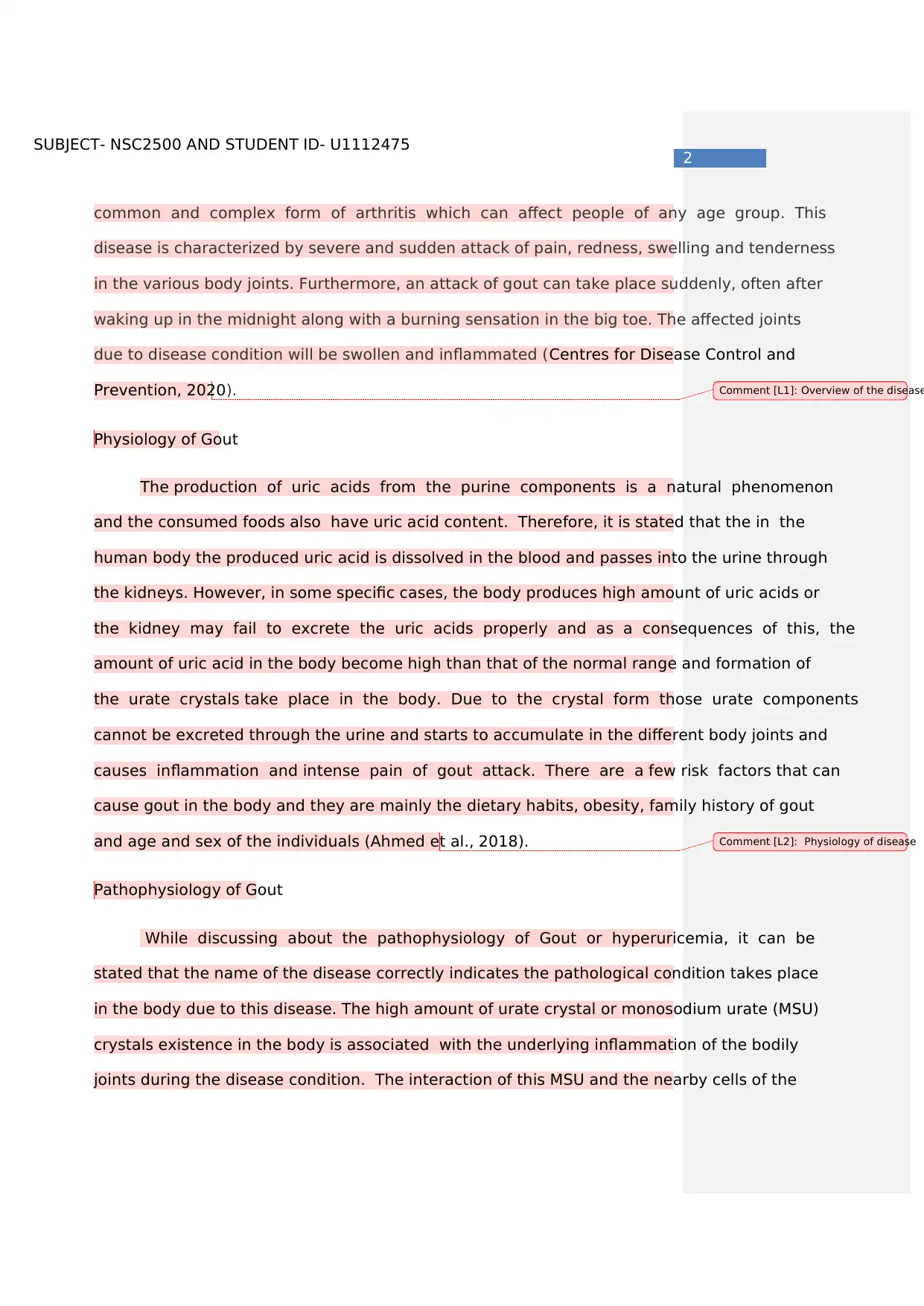
2
SUBJECT- NSC2500 AND STUDENT ID- U1112475
common and complex form of arthritis which can affect people of any age group. This
disease is characterized by severe and sudden attack of pain, redness, swelling and tenderness
in the various body joints. Furthermore, an attack of gout can take place suddenly, often after
waking up in the midnight along with a burning sensation in the big toe. The affected joints
due to disease condition will be swollen and inflammated (Centres for Disease Control and
Prevention, 2020).
Physiology of Gout
The production of uric acids from the purine components is a natural phenomenon
and the consumed foods also have uric acid content. Therefore, it is stated that the in the
human body the produced uric acid is dissolved in the blood and passes into the urine through
the kidneys. However, in some specific cases, the body produces high amount of uric acids or
the kidney may fail to excrete the uric acids properly and as a consequences of this, the
amount of uric acid in the body become high than that of the normal range and formation of
the urate crystals take place in the body. Due to the crystal form those urate components
cannot be excreted through the urine and starts to accumulate in the different body joints and
causes inflammation and intense pain of gout attack. There are a few risk factors that can
cause gout in the body and they are mainly the dietary habits, obesity, family history of gout
and age and sex of the individuals (Ahmed et al., 2018).
Pathophysiology of Gout
While discussing about the pathophysiology of Gout or hyperuricemia, it can be
stated that the name of the disease correctly indicates the pathological condition takes place
in the body due to this disease. The high amount of urate crystal or monosodium urate (MSU)
crystals existence in the body is associated with the underlying inflammation of the bodily
joints during the disease condition. The interaction of this MSU and the nearby cells of the
Comment [L1]: Overview of the disease
Comment [L2]: Physiology of disease
SUBJECT- NSC2500 AND STUDENT ID- U1112475
common and complex form of arthritis which can affect people of any age group. This
disease is characterized by severe and sudden attack of pain, redness, swelling and tenderness
in the various body joints. Furthermore, an attack of gout can take place suddenly, often after
waking up in the midnight along with a burning sensation in the big toe. The affected joints
due to disease condition will be swollen and inflammated (Centres for Disease Control and
Prevention, 2020).
Physiology of Gout
The production of uric acids from the purine components is a natural phenomenon
and the consumed foods also have uric acid content. Therefore, it is stated that the in the
human body the produced uric acid is dissolved in the blood and passes into the urine through
the kidneys. However, in some specific cases, the body produces high amount of uric acids or
the kidney may fail to excrete the uric acids properly and as a consequences of this, the
amount of uric acid in the body become high than that of the normal range and formation of
the urate crystals take place in the body. Due to the crystal form those urate components
cannot be excreted through the urine and starts to accumulate in the different body joints and
causes inflammation and intense pain of gout attack. There are a few risk factors that can
cause gout in the body and they are mainly the dietary habits, obesity, family history of gout
and age and sex of the individuals (Ahmed et al., 2018).
Pathophysiology of Gout
While discussing about the pathophysiology of Gout or hyperuricemia, it can be
stated that the name of the disease correctly indicates the pathological condition takes place
in the body due to this disease. The high amount of urate crystal or monosodium urate (MSU)
crystals existence in the body is associated with the underlying inflammation of the bodily
joints during the disease condition. The interaction of this MSU and the nearby cells of the
Comment [L1]: Overview of the disease
Comment [L2]: Physiology of disease
⊘ This is a preview!⊘
Do you want full access?
Subscribe today to unlock all pages.

Trusted by 1+ million students worldwide
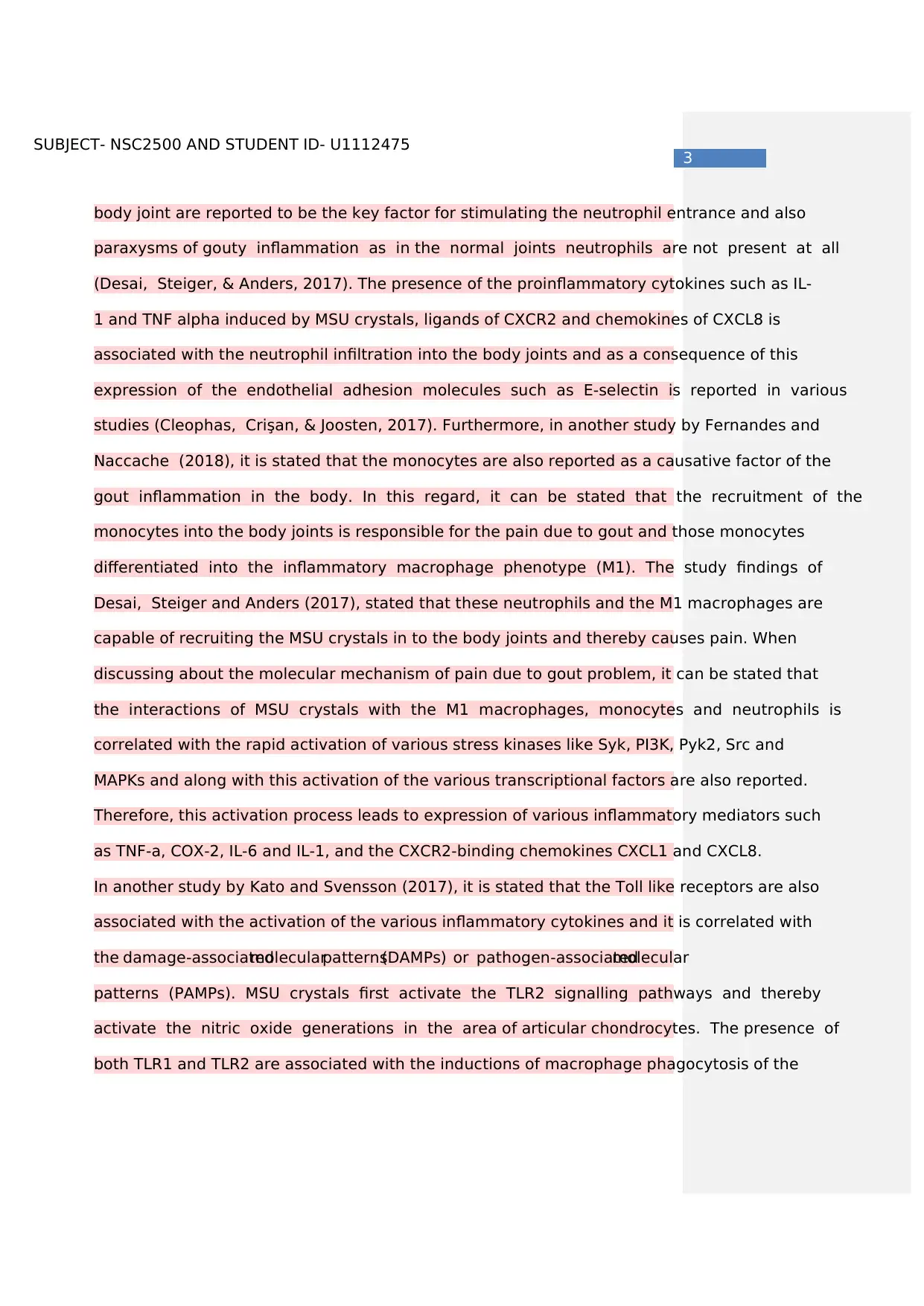
3
SUBJECT- NSC2500 AND STUDENT ID- U1112475
body joint are reported to be the key factor for stimulating the neutrophil entrance and also
paraxysms of gouty inflammation as in the normal joints neutrophils are not present at all
(Desai, Steiger, & Anders, 2017). The presence of the proinflammatory cytokines such as IL-
1 and TNF alpha induced by MSU crystals, ligands of CXCR2 and chemokines of CXCL8 is
associated with the neutrophil infiltration into the body joints and as a consequence of this
expression of the endothelial adhesion molecules such as E-selectin is reported in various
studies (Cleophas, Crişan, & Joosten, 2017). Furthermore, in another study by Fernandes and
Naccache (2018), it is stated that the monocytes are also reported as a causative factor of the
gout inflammation in the body. In this regard, it can be stated that the recruitment of the
monocytes into the body joints is responsible for the pain due to gout and those monocytes
differentiated into the inflammatory macrophage phenotype (M1). The study findings of
Desai, Steiger and Anders (2017), stated that these neutrophils and the M1 macrophages are
capable of recruiting the MSU crystals in to the body joints and thereby causes pain. When
discussing about the molecular mechanism of pain due to gout problem, it can be stated that
the interactions of MSU crystals with the M1 macrophages, monocytes and neutrophils is
correlated with the rapid activation of various stress kinases like Syk, PI3K, Pyk2, Src and
MAPKs and along with this activation of the various transcriptional factors are also reported.
Therefore, this activation process leads to expression of various inflammatory mediators such
as TNF-a, COX-2, IL-6 and IL-1, and the CXCR2-binding chemokines CXCL1 and CXCL8.
In another study by Kato and Svensson (2017), it is stated that the Toll like receptors are also
associated with the activation of the various inflammatory cytokines and it is correlated with
the damage-associatedmolecularpatterns(DAMPs) or pathogen-associatedmolecular
patterns (PAMPs). MSU crystals first activate the TLR2 signalling pathways and thereby
activate the nitric oxide generations in the area of articular chondrocytes. The presence of
both TLR1 and TLR2 are associated with the inductions of macrophage phagocytosis of the
SUBJECT- NSC2500 AND STUDENT ID- U1112475
body joint are reported to be the key factor for stimulating the neutrophil entrance and also
paraxysms of gouty inflammation as in the normal joints neutrophils are not present at all
(Desai, Steiger, & Anders, 2017). The presence of the proinflammatory cytokines such as IL-
1 and TNF alpha induced by MSU crystals, ligands of CXCR2 and chemokines of CXCL8 is
associated with the neutrophil infiltration into the body joints and as a consequence of this
expression of the endothelial adhesion molecules such as E-selectin is reported in various
studies (Cleophas, Crişan, & Joosten, 2017). Furthermore, in another study by Fernandes and
Naccache (2018), it is stated that the monocytes are also reported as a causative factor of the
gout inflammation in the body. In this regard, it can be stated that the recruitment of the
monocytes into the body joints is responsible for the pain due to gout and those monocytes
differentiated into the inflammatory macrophage phenotype (M1). The study findings of
Desai, Steiger and Anders (2017), stated that these neutrophils and the M1 macrophages are
capable of recruiting the MSU crystals in to the body joints and thereby causes pain. When
discussing about the molecular mechanism of pain due to gout problem, it can be stated that
the interactions of MSU crystals with the M1 macrophages, monocytes and neutrophils is
correlated with the rapid activation of various stress kinases like Syk, PI3K, Pyk2, Src and
MAPKs and along with this activation of the various transcriptional factors are also reported.
Therefore, this activation process leads to expression of various inflammatory mediators such
as TNF-a, COX-2, IL-6 and IL-1, and the CXCR2-binding chemokines CXCL1 and CXCL8.
In another study by Kato and Svensson (2017), it is stated that the Toll like receptors are also
associated with the activation of the various inflammatory cytokines and it is correlated with
the damage-associatedmolecularpatterns(DAMPs) or pathogen-associatedmolecular
patterns (PAMPs). MSU crystals first activate the TLR2 signalling pathways and thereby
activate the nitric oxide generations in the area of articular chondrocytes. The presence of
both TLR1 and TLR2 are associated with the inductions of macrophage phagocytosis of the
Paraphrase This Document
Need a fresh take? Get an instant paraphrase of this document with our AI Paraphraser
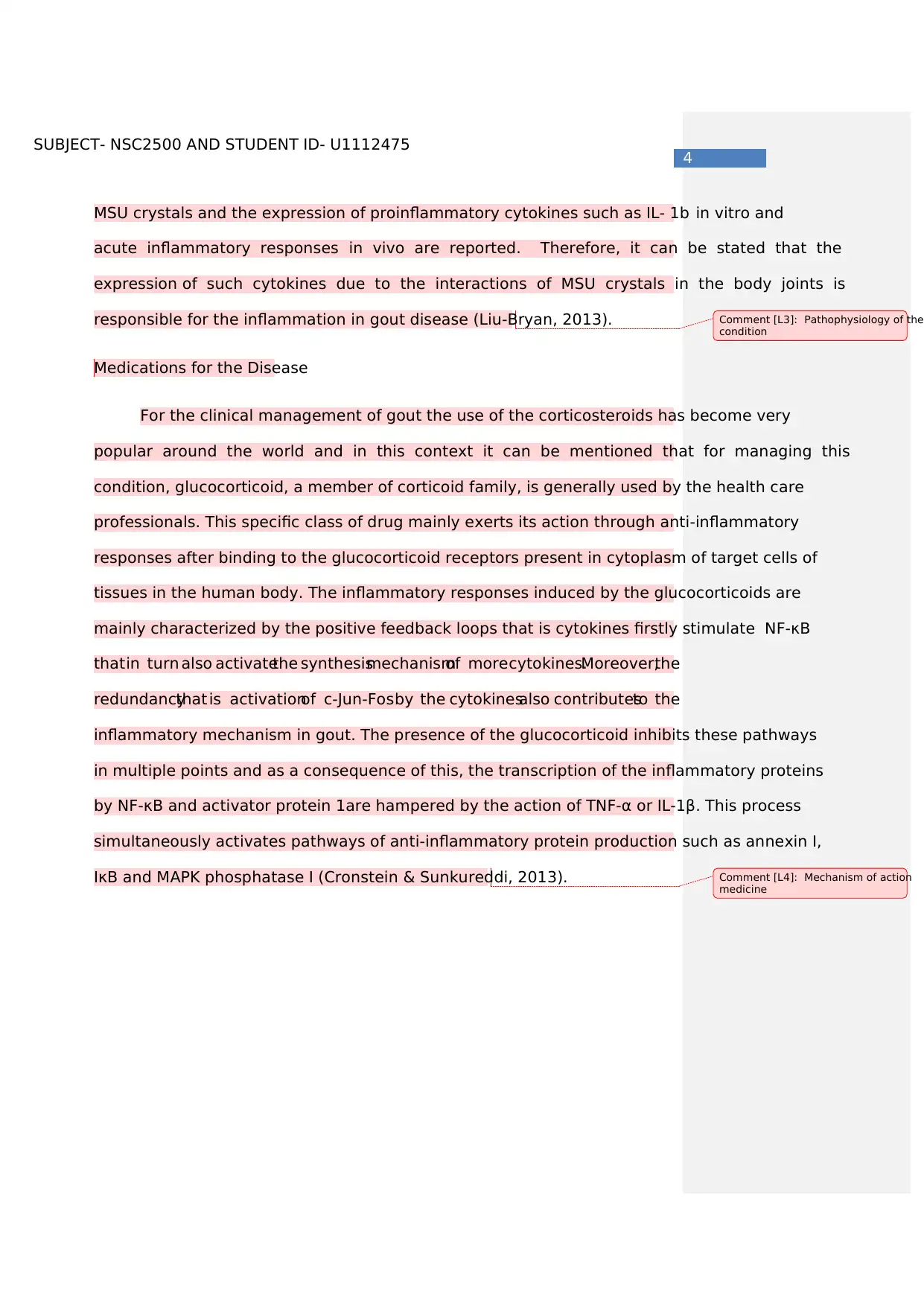
4
SUBJECT- NSC2500 AND STUDENT ID- U1112475
MSU crystals and the expression of proinflammatory cytokines such as IL- 1b in vitro and
acute inflammatory responses in vivo are reported. Therefore, it can be stated that the
expression of such cytokines due to the interactions of MSU crystals in the body joints is
responsible for the inflammation in gout disease (Liu-Bryan, 2013).
Medications for the Disease
For the clinical management of gout the use of the corticosteroids has become very
popular around the world and in this context it can be mentioned that for managing this
condition, glucocorticoid, a member of corticoid family, is generally used by the health care
professionals. This specific class of drug mainly exerts its action through anti-inflammatory
responses after binding to the glucocorticoid receptors present in cytoplasm of target cells of
tissues in the human body. The inflammatory responses induced by the glucocorticoids are
mainly characterized by the positive feedback loops that is cytokines firstly stimulate NF-κB
that in turn also activatethe synthesismechanismof more cytokines.Moreover,the
redundancythat is activationof c-Jun-Fos by the cytokinesalso contributesto the
inflammatory mechanism in gout. The presence of the glucocorticoid inhibits these pathways
in multiple points and as a consequence of this, the transcription of the inflammatory proteins
by NF-κB and activator protein 1are hampered by the action of TNF-α or IL-1β. This process
simultaneously activates pathways of anti-inflammatory protein production such as annexin I,
IκB and MAPK phosphatase I (Cronstein & Sunkureddi, 2013).
Comment [L3]: Pathophysiology of the
condition
Comment [L4]: Mechanism of action
medicine
SUBJECT- NSC2500 AND STUDENT ID- U1112475
MSU crystals and the expression of proinflammatory cytokines such as IL- 1b in vitro and
acute inflammatory responses in vivo are reported. Therefore, it can be stated that the
expression of such cytokines due to the interactions of MSU crystals in the body joints is
responsible for the inflammation in gout disease (Liu-Bryan, 2013).
Medications for the Disease
For the clinical management of gout the use of the corticosteroids has become very
popular around the world and in this context it can be mentioned that for managing this
condition, glucocorticoid, a member of corticoid family, is generally used by the health care
professionals. This specific class of drug mainly exerts its action through anti-inflammatory
responses after binding to the glucocorticoid receptors present in cytoplasm of target cells of
tissues in the human body. The inflammatory responses induced by the glucocorticoids are
mainly characterized by the positive feedback loops that is cytokines firstly stimulate NF-κB
that in turn also activatethe synthesismechanismof more cytokines.Moreover,the
redundancythat is activationof c-Jun-Fos by the cytokinesalso contributesto the
inflammatory mechanism in gout. The presence of the glucocorticoid inhibits these pathways
in multiple points and as a consequence of this, the transcription of the inflammatory proteins
by NF-κB and activator protein 1are hampered by the action of TNF-α or IL-1β. This process
simultaneously activates pathways of anti-inflammatory protein production such as annexin I,
IκB and MAPK phosphatase I (Cronstein & Sunkureddi, 2013).
Comment [L3]: Pathophysiology of the
condition
Comment [L4]: Mechanism of action
medicine
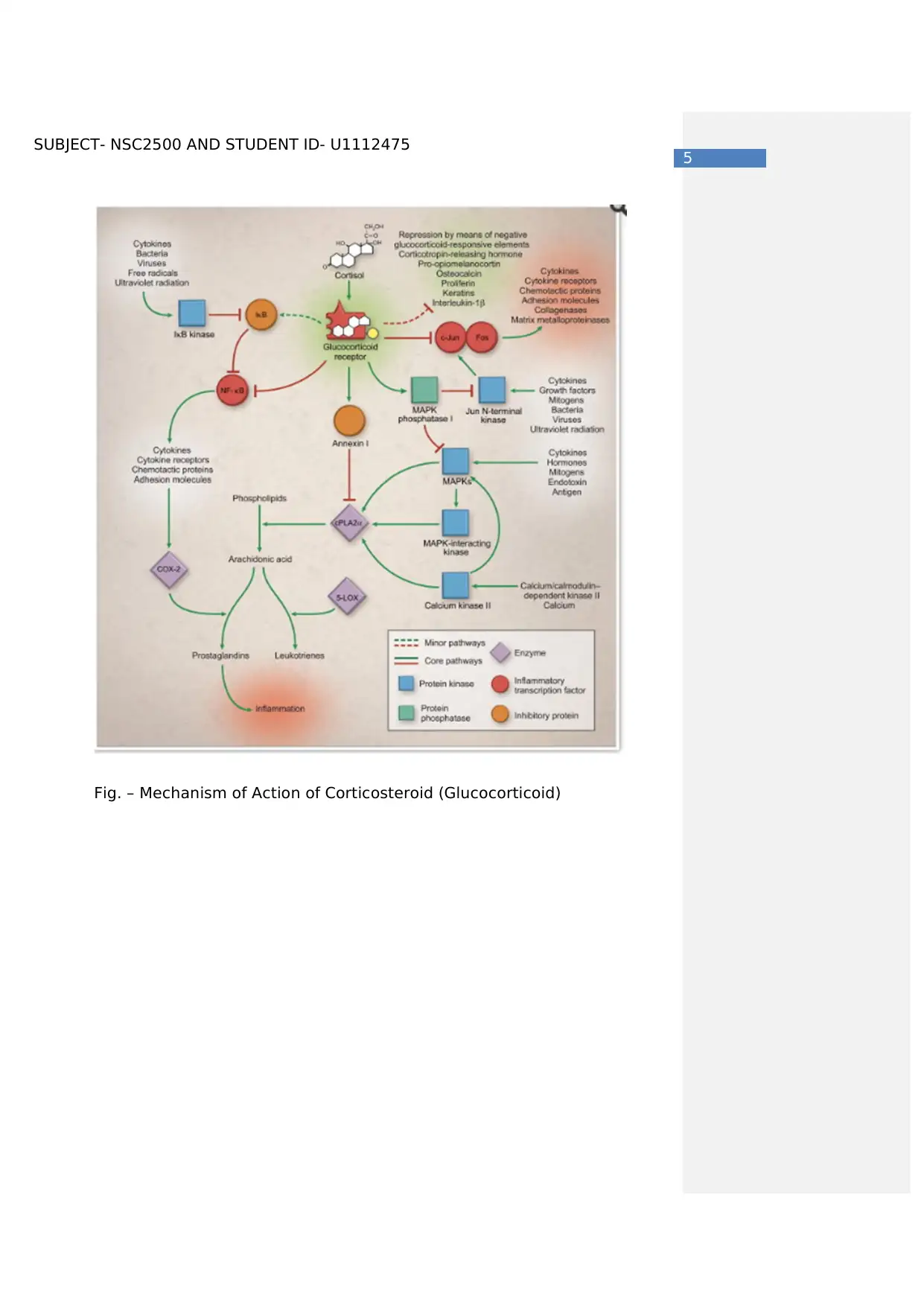
5
SUBJECT- NSC2500 AND STUDENT ID- U1112475
Fig. – Mechanism of Action of Corticosteroid (Glucocorticoid)
SUBJECT- NSC2500 AND STUDENT ID- U1112475
Fig. – Mechanism of Action of Corticosteroid (Glucocorticoid)
⊘ This is a preview!⊘
Do you want full access?
Subscribe today to unlock all pages.

Trusted by 1+ million students worldwide
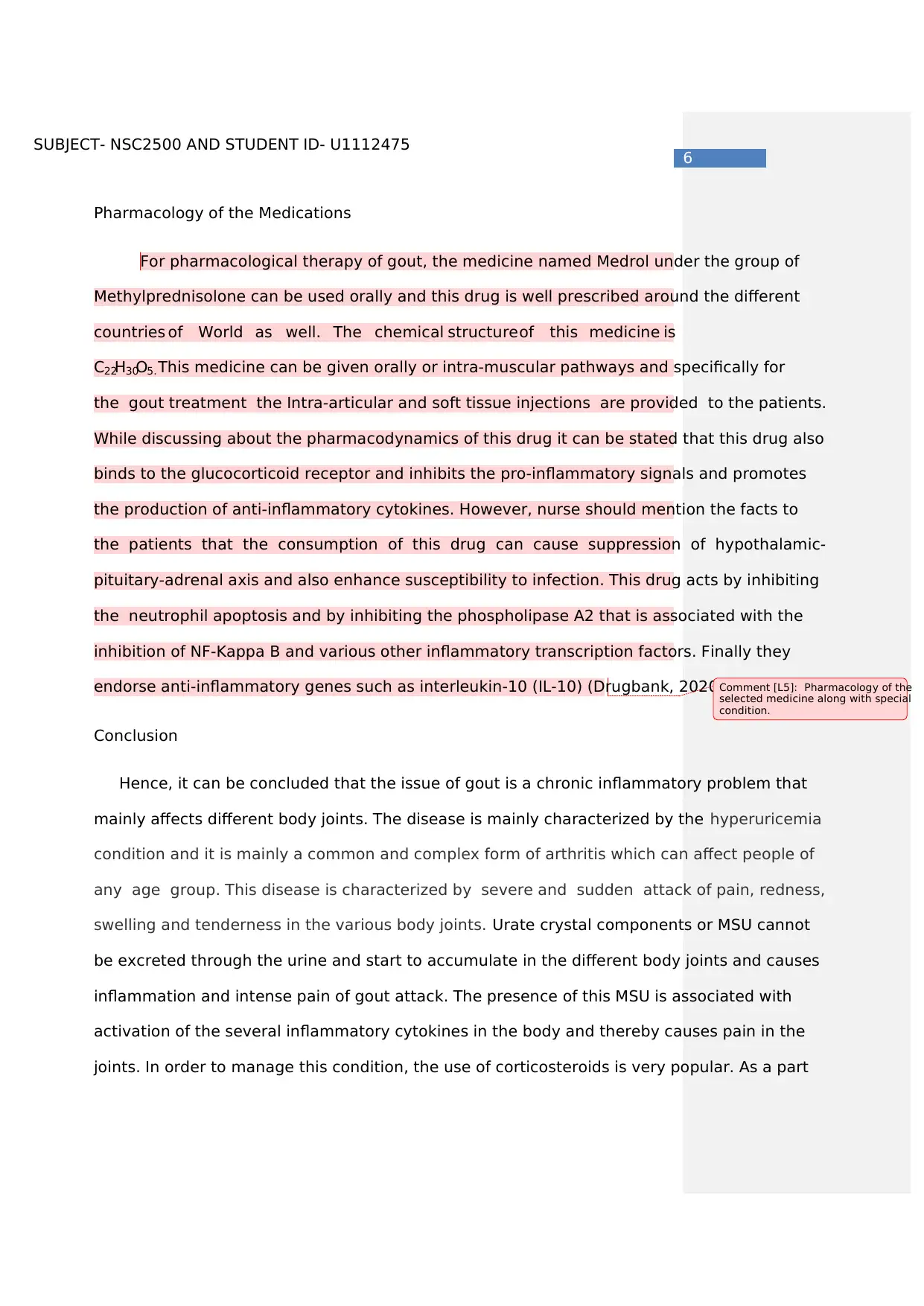
6
SUBJECT- NSC2500 AND STUDENT ID- U1112475
Pharmacology of the Medications
For pharmacological therapy of gout, the medicine named Medrol under the group of
Methylprednisolone can be used orally and this drug is well prescribed around the different
countries of World as well. The chemical structure of this medicine is
C22H30O5. This medicine can be given orally or intra-muscular pathways and specifically for
the gout treatment the Intra-articular and soft tissue injections are provided to the patients.
While discussing about the pharmacodynamics of this drug it can be stated that this drug also
binds to the glucocorticoid receptor and inhibits the pro-inflammatory signals and promotes
the production of anti-inflammatory cytokines. However, nurse should mention the facts to
the patients that the consumption of this drug can cause suppression of hypothalamic-
pituitary-adrenal axis and also enhance susceptibility to infection. This drug acts by inhibiting
the neutrophil apoptosis and by inhibiting the phospholipase A2 that is associated with the
inhibition of NF-Kappa B and various other inflammatory transcription factors. Finally they
endorse anti-inflammatory genes such as interleukin-10 (IL-10) (Drugbank, 2020).
Conclusion
Hence, it can be concluded that the issue of gout is a chronic inflammatory problem that
mainly affects different body joints. The disease is mainly characterized by the hyperuricemia
condition and it is mainly a common and complex form of arthritis which can affect people of
any age group. This disease is characterized by severe and sudden attack of pain, redness,
swelling and tenderness in the various body joints. Urate crystal components or MSU cannot
be excreted through the urine and start to accumulate in the different body joints and causes
inflammation and intense pain of gout attack. The presence of this MSU is associated with
activation of the several inflammatory cytokines in the body and thereby causes pain in the
joints. In order to manage this condition, the use of corticosteroids is very popular. As a part
Comment [L5]: Pharmacology of the
selected medicine along with special
condition.
SUBJECT- NSC2500 AND STUDENT ID- U1112475
Pharmacology of the Medications
For pharmacological therapy of gout, the medicine named Medrol under the group of
Methylprednisolone can be used orally and this drug is well prescribed around the different
countries of World as well. The chemical structure of this medicine is
C22H30O5. This medicine can be given orally or intra-muscular pathways and specifically for
the gout treatment the Intra-articular and soft tissue injections are provided to the patients.
While discussing about the pharmacodynamics of this drug it can be stated that this drug also
binds to the glucocorticoid receptor and inhibits the pro-inflammatory signals and promotes
the production of anti-inflammatory cytokines. However, nurse should mention the facts to
the patients that the consumption of this drug can cause suppression of hypothalamic-
pituitary-adrenal axis and also enhance susceptibility to infection. This drug acts by inhibiting
the neutrophil apoptosis and by inhibiting the phospholipase A2 that is associated with the
inhibition of NF-Kappa B and various other inflammatory transcription factors. Finally they
endorse anti-inflammatory genes such as interleukin-10 (IL-10) (Drugbank, 2020).
Conclusion
Hence, it can be concluded that the issue of gout is a chronic inflammatory problem that
mainly affects different body joints. The disease is mainly characterized by the hyperuricemia
condition and it is mainly a common and complex form of arthritis which can affect people of
any age group. This disease is characterized by severe and sudden attack of pain, redness,
swelling and tenderness in the various body joints. Urate crystal components or MSU cannot
be excreted through the urine and start to accumulate in the different body joints and causes
inflammation and intense pain of gout attack. The presence of this MSU is associated with
activation of the several inflammatory cytokines in the body and thereby causes pain in the
joints. In order to manage this condition, the use of corticosteroids is very popular. As a part
Comment [L5]: Pharmacology of the
selected medicine along with special
condition.
Paraphrase This Document
Need a fresh take? Get an instant paraphrase of this document with our AI Paraphraser
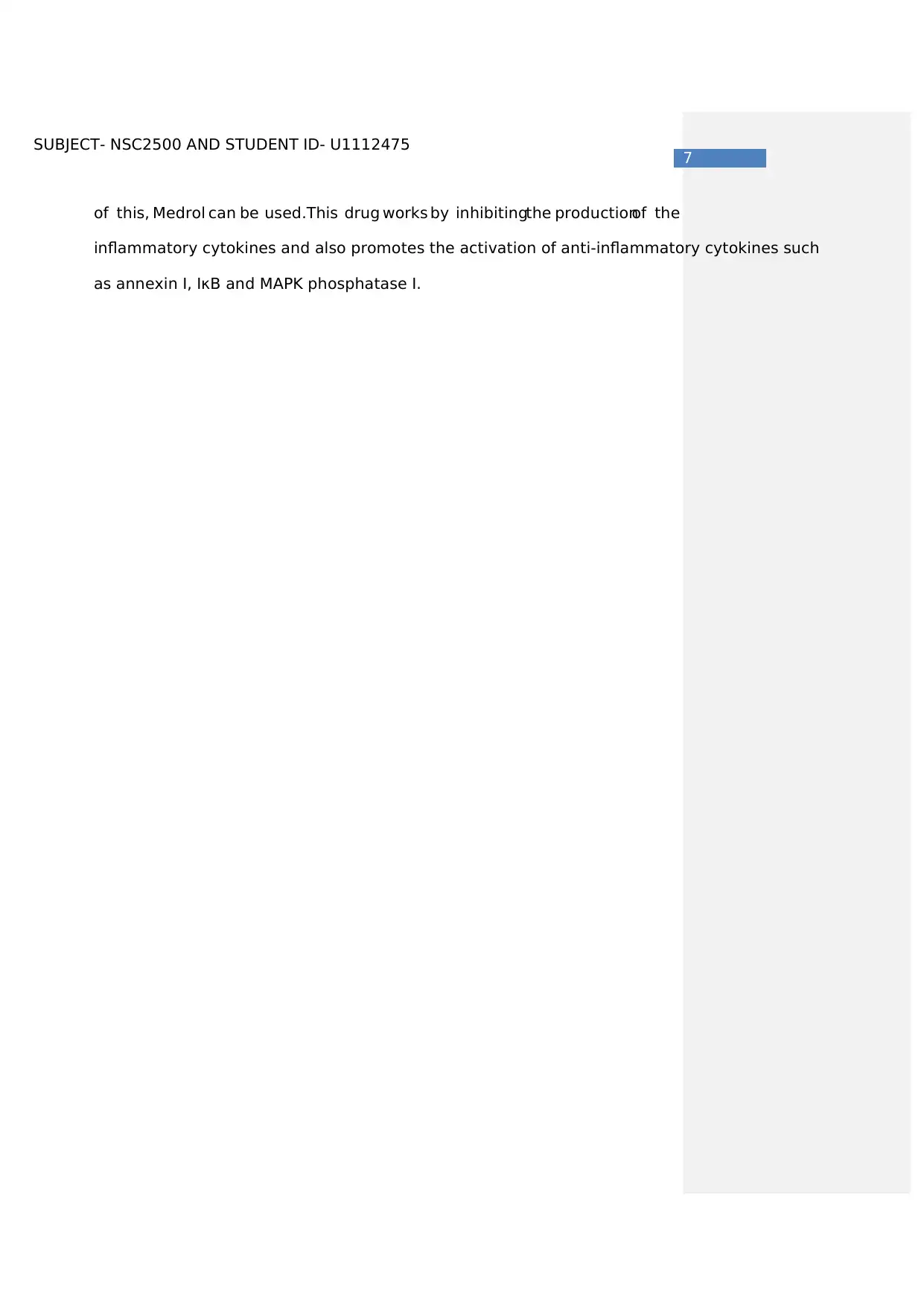
7
SUBJECT- NSC2500 AND STUDENT ID- U1112475
of this, Medrol can be used.This drug works by inhibitingthe productionof the
inflammatory cytokines and also promotes the activation of anti-inflammatory cytokines such
as annexin I, IκB and MAPK phosphatase I.
SUBJECT- NSC2500 AND STUDENT ID- U1112475
of this, Medrol can be used.This drug works by inhibitingthe productionof the
inflammatory cytokines and also promotes the activation of anti-inflammatory cytokines such
as annexin I, IκB and MAPK phosphatase I.
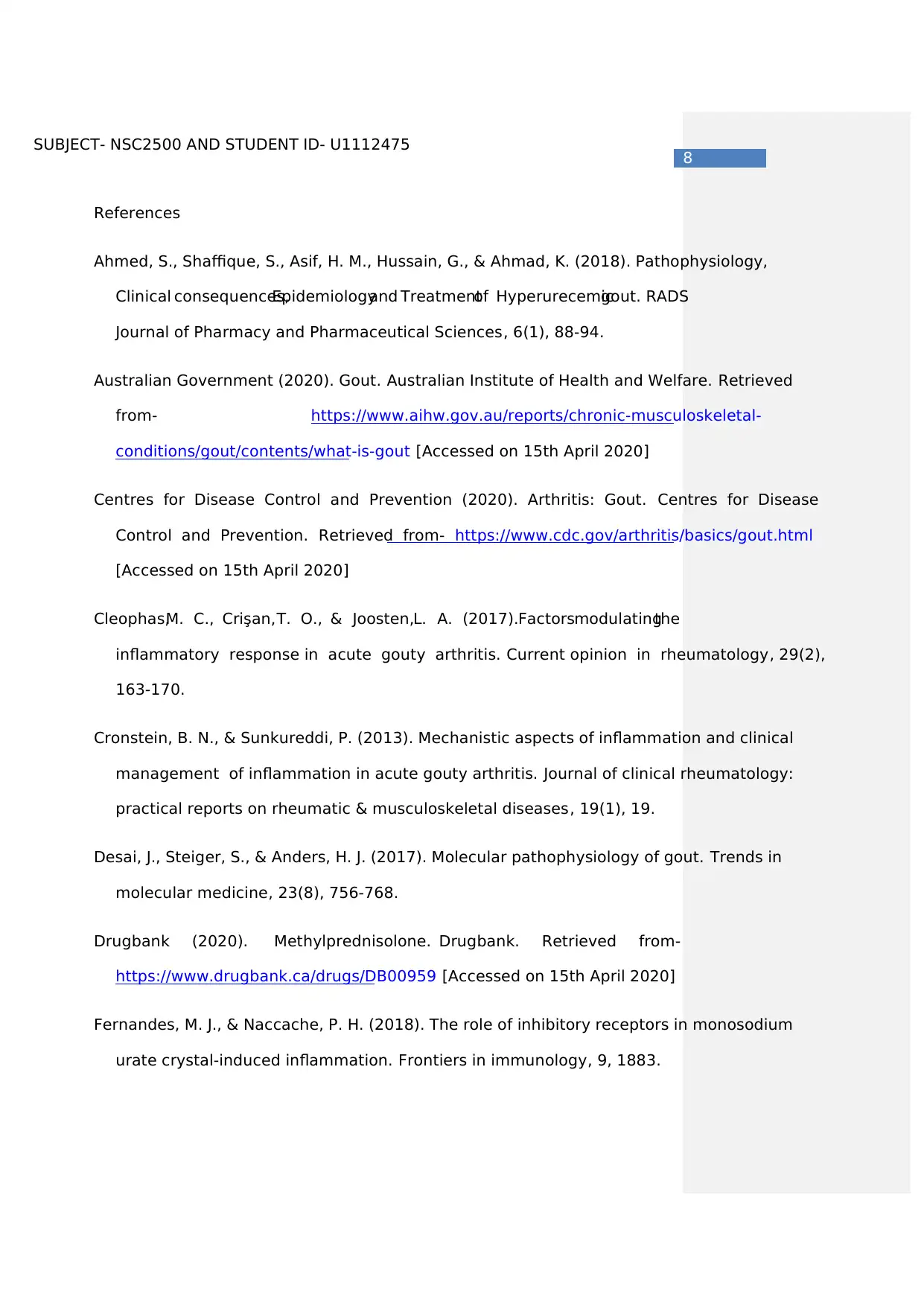
8
SUBJECT- NSC2500 AND STUDENT ID- U1112475
References
Ahmed, S., Shaffique, S., Asif, H. M., Hussain, G., & Ahmad, K. (2018). Pathophysiology,
Clinical consequences,Epidemiologyand Treatmentof Hyperurecemicgout. RADS
Journal of Pharmacy and Pharmaceutical Sciences, 6(1), 88-94.
Australian Government (2020). Gout. Australian Institute of Health and Welfare. Retrieved
from- https://www.aihw.gov.au/reports/chronic-musculoskeletal-
conditions/gout/contents/what-is-gout [Accessed on 15th April 2020]
Centres for Disease Control and Prevention (2020). Arthritis: Gout. Centres for Disease
Control and Prevention. Retrieved from- https://www.cdc.gov/arthritis/basics/gout.html
[Accessed on 15th April 2020]
Cleophas,M. C., Crişan, T. O., & Joosten,L. A. (2017).Factorsmodulatingthe
inflammatory response in acute gouty arthritis. Current opinion in rheumatology, 29(2),
163-170.
Cronstein, B. N., & Sunkureddi, P. (2013). Mechanistic aspects of inflammation and clinical
management of inflammation in acute gouty arthritis. Journal of clinical rheumatology:
practical reports on rheumatic & musculoskeletal diseases, 19(1), 19.
Desai, J., Steiger, S., & Anders, H. J. (2017). Molecular pathophysiology of gout. Trends in
molecular medicine, 23(8), 756-768.
Drugbank (2020). Methylprednisolone. Drugbank. Retrieved from-
https://www.drugbank.ca/drugs/DB00959 [Accessed on 15th April 2020]
Fernandes, M. J., & Naccache, P. H. (2018). The role of inhibitory receptors in monosodium
urate crystal-induced inflammation. Frontiers in immunology, 9, 1883.
SUBJECT- NSC2500 AND STUDENT ID- U1112475
References
Ahmed, S., Shaffique, S., Asif, H. M., Hussain, G., & Ahmad, K. (2018). Pathophysiology,
Clinical consequences,Epidemiologyand Treatmentof Hyperurecemicgout. RADS
Journal of Pharmacy and Pharmaceutical Sciences, 6(1), 88-94.
Australian Government (2020). Gout. Australian Institute of Health and Welfare. Retrieved
from- https://www.aihw.gov.au/reports/chronic-musculoskeletal-
conditions/gout/contents/what-is-gout [Accessed on 15th April 2020]
Centres for Disease Control and Prevention (2020). Arthritis: Gout. Centres for Disease
Control and Prevention. Retrieved from- https://www.cdc.gov/arthritis/basics/gout.html
[Accessed on 15th April 2020]
Cleophas,M. C., Crişan, T. O., & Joosten,L. A. (2017).Factorsmodulatingthe
inflammatory response in acute gouty arthritis. Current opinion in rheumatology, 29(2),
163-170.
Cronstein, B. N., & Sunkureddi, P. (2013). Mechanistic aspects of inflammation and clinical
management of inflammation in acute gouty arthritis. Journal of clinical rheumatology:
practical reports on rheumatic & musculoskeletal diseases, 19(1), 19.
Desai, J., Steiger, S., & Anders, H. J. (2017). Molecular pathophysiology of gout. Trends in
molecular medicine, 23(8), 756-768.
Drugbank (2020). Methylprednisolone. Drugbank. Retrieved from-
https://www.drugbank.ca/drugs/DB00959 [Accessed on 15th April 2020]
Fernandes, M. J., & Naccache, P. H. (2018). The role of inhibitory receptors in monosodium
urate crystal-induced inflammation. Frontiers in immunology, 9, 1883.
⊘ This is a preview!⊘
Do you want full access?
Subscribe today to unlock all pages.

Trusted by 1+ million students worldwide

9
SUBJECT- NSC2500 AND STUDENT ID- U1112475
Kato, J., & Svensson, C. I. (2015). Role of extracellular damage-associated molecular pattern
molecules (DAMPs) as mediators of persistent pain. In Progress in molecular biology and
translational science (Vol. 131, pp. 251-279). Academic Press.
Liu-Bryan, R. (2013). Pathophysiology and immunology of acute and chronic gout. Future
Medicine Ltd.
SUBJECT- NSC2500 AND STUDENT ID- U1112475
Kato, J., & Svensson, C. I. (2015). Role of extracellular damage-associated molecular pattern
molecules (DAMPs) as mediators of persistent pain. In Progress in molecular biology and
translational science (Vol. 131, pp. 251-279). Academic Press.
Liu-Bryan, R. (2013). Pathophysiology and immunology of acute and chronic gout. Future
Medicine Ltd.
1 out of 10
Related Documents
Your All-in-One AI-Powered Toolkit for Academic Success.
+13062052269
info@desklib.com
Available 24*7 on WhatsApp / Email
![[object Object]](/_next/static/media/star-bottom.7253800d.svg)
Unlock your academic potential
Copyright © 2020–2025 A2Z Services. All Rights Reserved. Developed and managed by ZUCOL.





